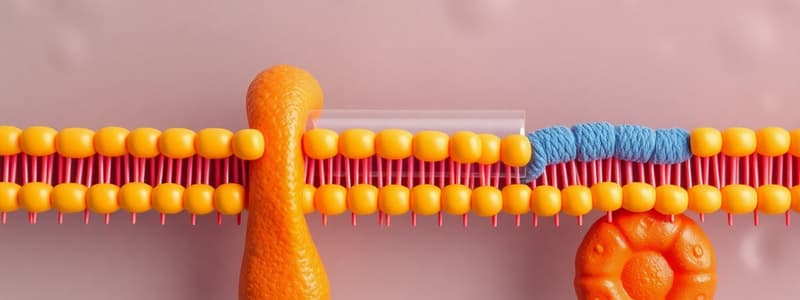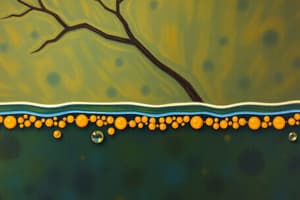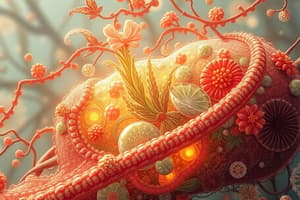Podcast
Questions and Answers
Which of the following is NOT a characteristic of facilitated diffusion?
Which of the following is NOT a characteristic of facilitated diffusion?
- It is a passive transport process.
- It requires a transmembrane protein to move molecules across the membrane.
- It moves molecules against their concentration gradient. (correct)
- It is a type of transport that is specific for certain molecules.
What is the main difference between simple diffusion and facilitated diffusion?
What is the main difference between simple diffusion and facilitated diffusion?
- Simple diffusion is a passive transport process, while facilitated diffusion is an active transport process.
- Simple diffusion moves molecules down their concentration gradient, while facilitated diffusion moves molecules against their concentration gradient.
- Simple diffusion can transport larger molecules, while facilitated diffusion can only transport small molecules.
- Simple diffusion requires a membrane protein, while facilitated diffusion does not. (correct)
Which of the following is an example of secondary active transport?
Which of the following is an example of secondary active transport?
- The movement of glucose into the cell along with sodium ions (Na+) using a symporter. (correct)
- The movement of oxygen (O2) across the membrane by simple diffusion.
- The movement of water across the membrane through aquaporins.
- The movement of sodium ions (Na+) out of the cell using the sodium-potassium pump.
What is the role of the sodium-potassium pump in coupled transport?
What is the role of the sodium-potassium pump in coupled transport?
What is the primary function of aquaporins?
What is the primary function of aquaporins?
Which of the following is NOT a type of ion channel?
Which of the following is NOT a type of ion channel?
Which of the following is an example of an antiporter?
Which of the following is an example of an antiporter?
What is the main difference between a carrier protein and an ion channel?
What is the main difference between a carrier protein and an ion channel?
What is the main factor that determines the rate of simple diffusion?
What is the main factor that determines the rate of simple diffusion?
Which of the following is TRUE about the selectivity of ion channels?
Which of the following is TRUE about the selectivity of ion channels?
What is the main difference between a symporter and an antiporter?
What is the main difference between a symporter and an antiporter?
Which of the following statements about the sodium-potassium pump is TRUE?
Which of the following statements about the sodium-potassium pump is TRUE?
What is the role of the acetylcholine receptor at the neuromuscular junction?
What is the role of the acetylcholine receptor at the neuromuscular junction?
What is the main difference between osmosis and diffusion?
What is the main difference between osmosis and diffusion?
Which of the following statements about the movement of molecules across the membrane is TRUE?
Which of the following statements about the movement of molecules across the membrane is TRUE?
Which of the following statements about coupled transport is TRUE?
Which of the following statements about coupled transport is TRUE?
Which of these transport mechanisms directly uses ATP to move molecules against their concentration gradient?
Which of these transport mechanisms directly uses ATP to move molecules against their concentration gradient?
What is the primary function of the Na⁺-K⁺ pump?
What is the primary function of the Na⁺-K⁺ pump?
What type of transport mechanism is used by ABC transporters?
What type of transport mechanism is used by ABC transporters?
How does MDR transporter contribute to drug resistance?
How does MDR transporter contribute to drug resistance?
Which of the following transport mechanisms does NOT require energy input?
Which of the following transport mechanisms does NOT require energy input?
What is the role of the calcium pump in maintaining cellular function?
What is the role of the calcium pump in maintaining cellular function?
Which of the following statements about secondary active transport is TRUE?
Which of the following statements about secondary active transport is TRUE?
What type of transport mechanism is responsible for the movement of water across the cell membrane?
What type of transport mechanism is responsible for the movement of water across the cell membrane?
Which of the following molecules is LEAST likely to move across the cell membrane by simple diffusion?
Which of the following molecules is LEAST likely to move across the cell membrane by simple diffusion?
What is the significance of the proton pump in regulating the acidity of stomach cells?
What is the significance of the proton pump in regulating the acidity of stomach cells?
Which of the following transport proteins is responsible for the transmembrane conductance of chloride ions in cystic fibrosis?
Which of the following transport proteins is responsible for the transmembrane conductance of chloride ions in cystic fibrosis?
Which of the following statements regarding symporters is TRUE?
Which of the following statements regarding symporters is TRUE?
Why is the Na⁺-K⁺ pump often considered essential for secondary active transport?
Why is the Na⁺-K⁺ pump often considered essential for secondary active transport?
The accumulation of Na+ ions inside the cell has what consequence on secondary active transport?
The accumulation of Na+ ions inside the cell has what consequence on secondary active transport?
What is the primary reason that water moves through a semi-permeable membrane from a high water potential to a low water potential?
What is the primary reason that water moves through a semi-permeable membrane from a high water potential to a low water potential?
Flashcards
ATP Usage in Transport
ATP Usage in Transport
ATP is required to pump Na+ out of cells during secondary active transport.
Coupled Transport
Coupled Transport
Movement of one solute drives the movement of another in cells, can be symport or antiport.
Secondary Active Transport
Secondary Active Transport
Uses energy from moving one molecule down its gradient to move another up its gradient.
Antiporters
Antiporters
Signup and view all the flashcards
Symporters
Symporters
Signup and view all the flashcards
Simple Diffusion
Simple Diffusion
Signup and view all the flashcards
Facilitated Diffusion
Facilitated Diffusion
Signup and view all the flashcards
Ion Channels
Ion Channels
Signup and view all the flashcards
Voltage-gated Channels
Voltage-gated Channels
Signup and view all the flashcards
Ligand-gated Channels
Ligand-gated Channels
Signup and view all the flashcards
Mechanosensitive Channels
Mechanosensitive Channels
Signup and view all the flashcards
Osmosis
Osmosis
Signup and view all the flashcards
Aquaporins
Aquaporins
Signup and view all the flashcards
Ion Selectivity
Ion Selectivity
Signup and view all the flashcards
GLUT-1 Transporter
GLUT-1 Transporter
Signup and view all the flashcards
Na⁺-K⁺ Pump
Na⁺-K⁺ Pump
Signup and view all the flashcards
Primary Active Transport
Primary Active Transport
Signup and view all the flashcards
Calcium Pump
Calcium Pump
Signup and view all the flashcards
Proton Pump
Proton Pump
Signup and view all the flashcards
Semi-permeable Membrane
Semi-permeable Membrane
Signup and view all the flashcards
Passive Transport
Passive Transport
Signup and view all the flashcards
ABC Transporters
ABC Transporters
Signup and view all the flashcards
MDR Transporter
MDR Transporter
Signup and view all the flashcards
CFTR
CFTR
Signup and view all the flashcards
Importers & Exporters
Importers & Exporters
Signup and view all the flashcards
Cell Membrane Functions
Cell Membrane Functions
Signup and view all the flashcards
Study Notes
Transmembrane Transport of Small Molecules and Ions
- Plasma Membrane: Semi-permeable, controlling entry and exit of molecules.
- Passive Transport: Movement without energy input, follows concentration gradient.
- Simple Diffusion: Small, hydrophobic molecules (O2, CO2, steroids) pass directly through the lipid bilayer.
- Facilitated Diffusion: Larger/charged molecules use transport proteins (channels or carriers). Examples include GLUT-1 (glucose transporter).
- Osmosis: Movement of water across a membrane down its osmotic gradient, often through aquaporins.
- Active Transport: Requires energy (usually ATP) to move molecules against their concentration gradient.
- Primary Active Transport: Direct use of ATP. Examples include Na+/K+ pump, calcium pump, proton pump.
- Secondary Active Transport (Coupled Transport): Uses energy from one molecule moving down its gradient to move another molecule up its gradient. Examples include symporters (e.g., Na+/glucose co-transporter) and antiporters (e.g., Na+/Ca2+ exchanger).
- Ion Channels: Pathways for specific ions to rapidly pass through the membrane. Types include:
- Voltage-gated: Open/close in response to changes in membrane potential.
- Ligand-gated: Open/close when a specific molecule (ligand) binds.
- Mechanosensitive: Respond to mechanical forces (e.g., stretching).
- Ion Selectivity: Channels are selective, allowing specific ions to pass.
- Carrier Proteins: Bind to a molecule and then undergo conformational changes to transport it.
Key Transporters
- Na+/K+ Pump: Pumps 3 Na+ out and 2 K+ in per ATP hydrolyzed. Maintains membrane potential and regulates cell volume.
- Calcium Pump: Maintains low intracellular Ca2+ concentration.
- Proton Pump: Regulates acidity in stomach cells and organelles.
- ABC Transporters (ATP-binding cassette): Largest family of ATP-hydrolysis-coupled transporters. Import nutrients and export toxins/drugs/antibiotics.
- Specific Examples: MDR transporter (multidrug resistance) and CFTR (Cystic Fibrosis Transmembrane Conductance Regulator) are categorized as ABC transporters.
Active Transport
- Mechanisms: Secondary active transport couples the movement of one solute to the movement of another.
- Importance: Maintains gradients and allows cells to accumulate essential nutrients and export toxins.
Studying That Suits You
Use AI to generate personalized quizzes and flashcards to suit your learning preferences.




